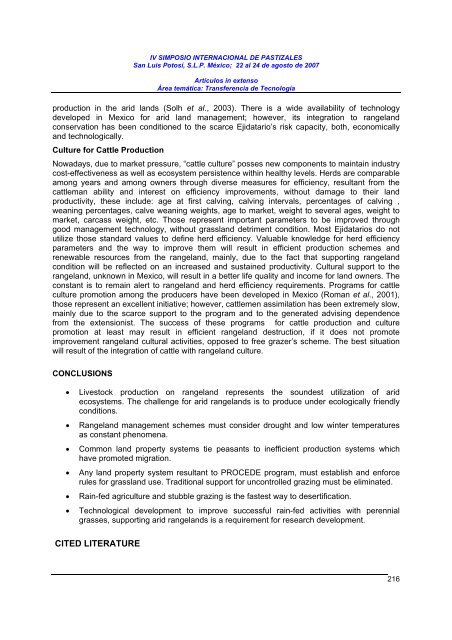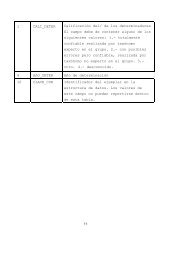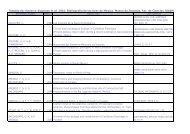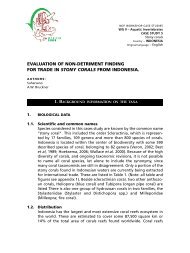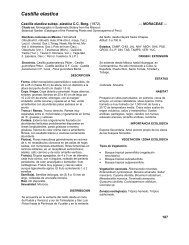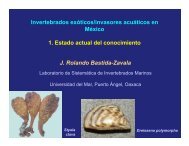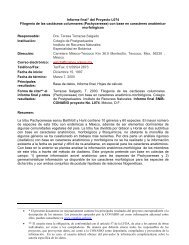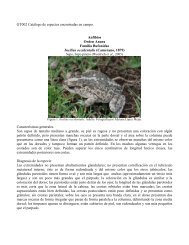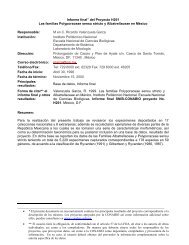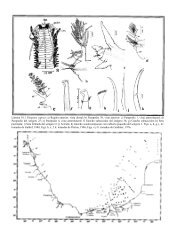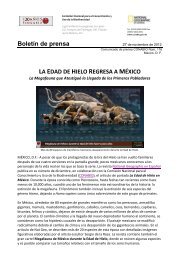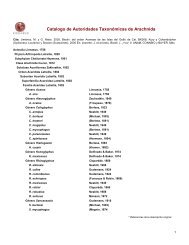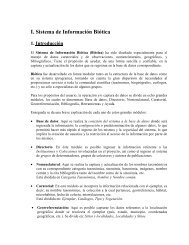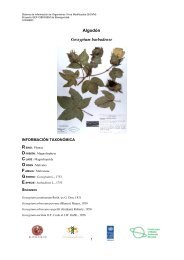ecosystem services to and from north american arid ... - Conabio
ecosystem services to and from north american arid ... - Conabio
ecosystem services to and from north american arid ... - Conabio
Create successful ePaper yourself
Turn your PDF publications into a flip-book with our unique Google optimized e-Paper software.
IV SIMPOSIO INTERNACIONAL DE PASTIZALES<br />
San Luis Po<strong>to</strong>sí, S.L.P. México; 22 al 24 de agos<strong>to</strong> de 2007<br />
Artículos in extenso<br />
Área temática: Transferencia de Tecnología<br />
production in the <strong>arid</strong> l<strong>and</strong>s (Solh et al., 2003). There is a wide availability of technology<br />
developed in Mexico for <strong>arid</strong> l<strong>and</strong> management; however, its integration <strong>to</strong> rangel<strong>and</strong><br />
conservation has been conditioned <strong>to</strong> the scarce Ejidatario’s risk capacity, both, economically<br />
<strong>and</strong> technologically.<br />
Culture for Cattle Production<br />
Nowadays, due <strong>to</strong> market pressure, “cattle culture” posses new components <strong>to</strong> maintain industry<br />
cost-effectiveness as well as <strong>ecosystem</strong> persistence within healthy levels. Herds are comparable<br />
among years <strong>and</strong> among owners through diverse measures for efficiency, resultant <strong>from</strong> the<br />
cattleman ability <strong>and</strong> interest on efficiency improvements, without damage <strong>to</strong> their l<strong>and</strong><br />
productivity, these include: age at first calving, calving intervals, percentages of calving ,<br />
weaning percentages, calve weaning weights, age <strong>to</strong> market, weight <strong>to</strong> several ages, weight <strong>to</strong><br />
market, carcass weight, etc. Those represent important parameters <strong>to</strong> be improved through<br />
good management technology, without grassl<strong>and</strong> detriment condition. Most Ejidatarios do not<br />
utilize those st<strong>and</strong>ard values <strong>to</strong> define herd efficiency. Valuable knowledge for herd efficiency<br />
parameters <strong>and</strong> the way <strong>to</strong> improve them will result in efficient production schemes <strong>and</strong><br />
renewable resources <strong>from</strong> the rangel<strong>and</strong>, mainly, due <strong>to</strong> the fact that supporting rangel<strong>and</strong><br />
condition will be reflected on an increased <strong>and</strong> sustained productivity. Cultural support <strong>to</strong> the<br />
rangel<strong>and</strong>, unknown in Mexico, will result in a better life quality <strong>and</strong> income for l<strong>and</strong> owners. The<br />
constant is <strong>to</strong> remain alert <strong>to</strong> rangel<strong>and</strong> <strong>and</strong> herd efficiency requirements. Programs for cattle<br />
culture promotion among the producers have been developed in Mexico (Roman et al., 2001),<br />
those represent an excellent initiative; however, cattlemen assimilation has been extremely slow,<br />
mainly due <strong>to</strong> the scarce support <strong>to</strong> the program <strong>and</strong> <strong>to</strong> the generated advising dependence<br />
<strong>from</strong> the extensionist. The success of these programs for cattle production <strong>and</strong> culture<br />
promotion at least may result in efficient rangel<strong>and</strong> destruction, if it does not promote<br />
improvement rangel<strong>and</strong> cultural activities, opposed <strong>to</strong> free grazer’s scheme. The best situation<br />
will result of the integration of cattle with rangel<strong>and</strong> culture.<br />
CONCLUSIONS<br />
• Lives<strong>to</strong>ck production on rangel<strong>and</strong> represents the soundest utilization of <strong>arid</strong><br />
<strong>ecosystem</strong>s. The challenge for <strong>arid</strong> rangel<strong>and</strong>s is <strong>to</strong> produce under ecologically friendly<br />
conditions.<br />
• Rangel<strong>and</strong> management schemes must consider drought <strong>and</strong> low winter temperatures<br />
as constant phenomena.<br />
• Common l<strong>and</strong> property systems tie peasants <strong>to</strong> inefficient production systems which<br />
have promoted migration.<br />
• Any l<strong>and</strong> property system resultant <strong>to</strong> PROCEDE program, must establish <strong>and</strong> enforce<br />
rules for grassl<strong>and</strong> use. Traditional support for uncontrolled grazing must be eliminated.<br />
• Rain-fed agriculture <strong>and</strong> stubble grazing is the fastest way <strong>to</strong> desertification.<br />
• Technological development <strong>to</strong> improve successful rain-fed activities with perennial<br />
grasses, supporting <strong>arid</strong> rangel<strong>and</strong>s is a requirement for research development.<br />
CITED LITERATURE<br />
216


